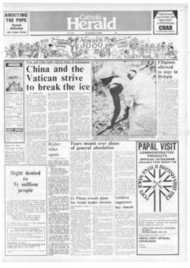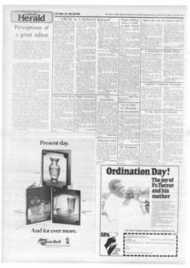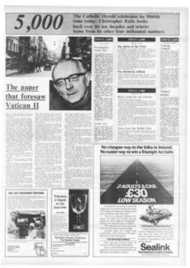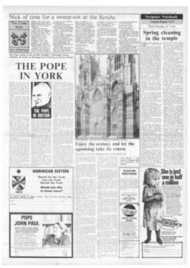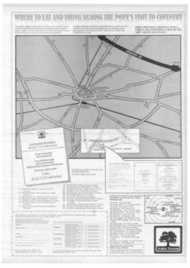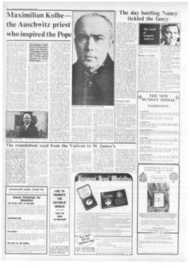Page 12, 12th March 1982
Page 12

Report an error
Noticed an error on this page?If you've noticed an error in this article please click here to report it.
Tags
Share
Related articles
Maximilian Kolbe : The Model Priest
The Poland The Pope Is Seeing
Kolbe ` Not Anti-semiti C Say Scholars
Fr Kolbe To Be Canonized
Beatification For Fr. Kolbe
Maximilian Kolbe the Auschwitz priest who inspired the Pope
Maximilian Kolbe is to be declared a saint in October. Christopher Howse shows how much the Polish priest means to Pope John Paul.
NO NEW saints have yet been canonised during the reign of Pope John Paul. On October 10 he will preside over the canonisation ceremony in St Peter's of Maximilian Kolbe, the Polish priest who was killed in Auschwitz in 1941.
Pope John Paul, as Cardinal Wojtyla, was present at Fr Kolbe's beatification ceremony M Rome in 1971. For him and his Primate, Cardinal Wyszynski, Kolbe stood for the unity between the Church and State of Poland. But it has become clear, since the election of the first Polish Pope that to Pope John Paul he means much more.
The Pope held up Maximilian Kolbe as a model of pastoral initiative. In what may be seen as one of his first urgent tasks, the letter to Priests of April 1979, Pope John Paul says: "'The supreme art is the direction of souls,' wrote St Gregory the Great. I say to you therefore, quoting these words of his strive to be artists of pastoral work . There have been many such in the history of the Church St Vincent de Paul, St John of Avila, the holy Cure dArs, St John Bosco, Blessed Maximilian Kolbe."
7 Fr Kolbe's remarkable pastoral preoccupation is apparent from the outline of his life. Born of poor parents in 1894, he set off for the seminary at the age of 13 after a parish mission given by the Franciscans. He was soon joined by his two brothers. His parents had taught him to love God and his native land. For the rest of his life he adhered to the Franciscan Kolbe's life was characterised by a remarkable, some would think exaggerated devotion to Mary Immaculate. It was only after his death that his mother revealed that Raymond, as he was called before entering religion, had seen a vision of Our Lady offering him two crowns one red and one white. The white one signified purity and the red one martyrdom. I reached for both of them."
Fr Kolbe's compelling ambition to achieve even greater tasks for the sake of Our Lady resulted in his founding a association rather ungraciously translated as the Militia of the Immaculate. It came to number millions around the world as members. In Poland, against the sympathy of some of his Franciscan brothers, he founded Niepokalanow, the City of Mary Immaculate, a friary which before the war became one of the largest in the world, with 750 Franciscans. From there he published a newspaper called Knight of the Immaculate which came to have a circulation of more than a million. In 1930, Maximilian Kolbe was chosen by his superiors to found a mission in Japan. The communities set up in Nagasaki and other cities, still flourish. After the bombing of Nagasaki, the friars were able to show care for the suffering people.
In 1936, he returned to Poland, but was arrested by the German invaders shortty after the outbreak of war and Niepokalanow was disbanded. Fr Kolbe was released for a time and a reduced community began work to help injured and starving internees billeted on the friary. They even managed to publish one edition of Knight of the Immaculate, before Fr Kolbe was arrested again and sent to Auschwitz.
In Auschwitz, Kolbe suffered the now familiar horrors of concentration camp life. When a prisoner escaped one day, the commandant ordered ten men to die by starvation. One of them, Franciszek Gajowniczek, burst into tears, crying that he had a family. It was then that Fr Kolbe offered to take his place.
It is important to note the apparent motives for his offer. First, he was laying down his life for another in an entirely altruistic way. Secondly, he wished to carry his pastoral care to its ultimate conclusion to be with his flock at their deaths.
After two weeks in an underground cell without clothes, food or water, Fr Kolbe and three others were still alive. He had, according to the testimony of survivors from the camp, succeeded in bringing calm and even hope to the not unnaturally tortured atmosphere of the death cell. The survivors were killed with an injection of phenol. Fr Kolbe's body was incinerated and his ashes were spread by the wind.
At his beatification ceremony, Cardinal Karol Wojtyla told the press: "At a moment when so many priests throughout the world question themselves regarding their identity, Father Maximilian Kolbe appears among us to give his answer, not by theological discourses, but by his life and death."
When the Archbishop of Krakow was elected Pope, he returned to this theme in tackling the crisis facing many priests in the world. When he visited Poland again and spoke to the priests there, he recalled the heroism of the priests who has died in the concentration camps. To priests in Mexico, early in his reign he said: "Servants of a sublime cause, the fate of the church in those sectors entrusted to your pastoral care depends largely upon you. This imposes upon you a profound awareness of the greatness of the mission received and the necessity of preparing yourselves continually for it.
"It means, in effect, dear brothers and sons, that it is the church of Christ what respect and love this should inspire in us which you should serve joyously in holiness of life.
"This high and exacting service could not be given without a clear and deep-rooted conviction of your identity as priests of Christ, as keepers and administrators of the mysteries of God, instruments of salvation for mankind, witnesses of a kingdom which begins in this world but which is fulfilled in the hereafter. .Confronted by these truths of the faith, why do you doubt your own identity? Why vacillate in regard to the value of your own life? Why hesitate before the road taken?"
What often looks like severity in Pope John Paul's treatment of priests in fact derives from the high vision of the priesthood that he has acquired. And that vision is not attributable merely to theological training, but to a sort of hero worship. He has found a model of the priesthood that Christ initiated in Maximilian Kolbe.
blog comments powered by Disqus


